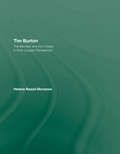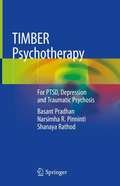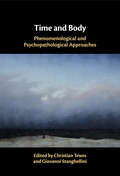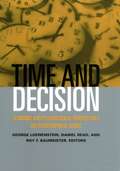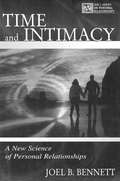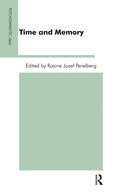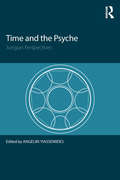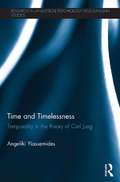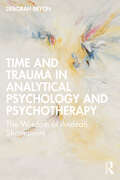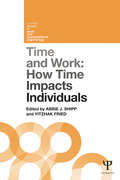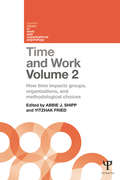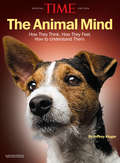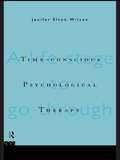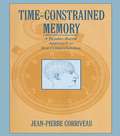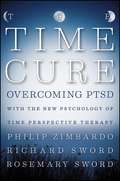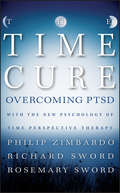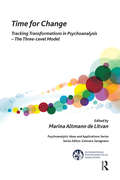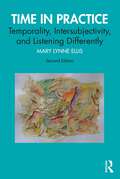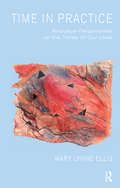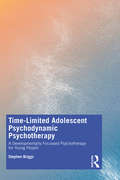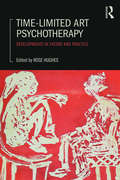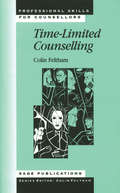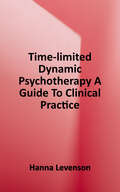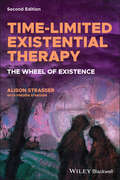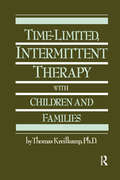- Table View
- List View
Tim Burton: A Post-Jungian Perspective
by Helena Bassil-MorozowTim Burton’s films are well known for being complex and emotionally powerful. In this book, Helena Bassil-Morozow employs Jungian and post-Jungian concepts of unconscious mental processes along with film semiotics, analysis of narrative devices and cinematic history, to explore the reworking of myth and fairytale in Burton’s gothic fantasy world. The book explores the idea that Burton’s lonely, rebellious ‘monstrous’ protagonists roam the earth because they are unable to fit into the normalising tendencies of society and become part of ‘the crowd’. Divided into six chapters the book considers the concept of the archetype in various settings focusing on: the child the monster the superhero the genius the maniac the monstrous society. Tim Burton: The Monster and the Crowd offers an entirely fresh perspective on Tim Burton’s works. The book is essential reading for students and scholars of film or Jungian psychology, as well as anyone interested in critical issues in contemporary culture. It will also be of great help to those fans of Tim Burton who have been searching for a profound academic analysis of his works.
TIMBER Psychotherapy: For PTSD, Depression and Traumatic Psychosis
by Shanaya Rathod Basant Pradhan Narsimha R. PinnintiTIMBER psychotherapy is a novel, translational and biomarker informed, mindfulness-based cognitive behavioral therapy approach that addresses some of the current treatment gaps for PTSD, depression and traumatic psychosis. This treatment manual offers practitioners and patients alike a step-by-step guide to TIMBER (acronym for Trauma Interventions using Mindfulness Based Extinction and Reconsolidation of memories) psychotherapy, and has been divided into four parts: Understanding Complex Trauma and Traumatic Psychosis; Methodology and Application; Training Professionals; and Policy Implications & Future Research Directions. In addition to a strong rationale and evidence base for the TIMBER approach, the book also provides case examples accompanied by videos (available separately). Its special features include reproducible client handouts, assessment tools, and a list of resources for training to use TIMBER.
Time and Body: Phenomenological and Psychopathological Approaches
by Christian Tewes Giovanni StanghelliniTime and Body promotes the application of phenomenological psychopathology and embodied research to a broad spectrum of mental disorders. In a new and practical way, it integrates the latest research on the temporal and intersubjective constitution of the body, self and its mental disorders from phenomenological, embodied and interdisciplinary research perspectives. The authors investigate how temporal processes apply to the contribution of embodiment and selfhood, as well as to their destabilization, such as in eating disorders and borderline personality disorders, schizophrenia, depression, social anxiety or dementia. The chapters demonstrate the applicability of phenomenological psychopathology to a range of illnesses and its relevance to treatment and clinical practice.
Time and Decision: Economic and Psychological Perspectives of Intertemporal Choice
by Daniel Read George Loewenstein Roy F. BaumeisterHow do people decide whether to sacrifice now for a future reward or to enjoy themselves in the present? Do the future gains of putting money in a pension fund outweigh going to Hawaii for New Year's Eve? Why does a person's self-discipline one day often give way to impulsive behavior the next? Time and Decision takes up these questions with a comprehensive collection of new research on intertemporal choice, examining how people face the problem of deciding over time. Economists approach intertemporal choice by means of a model in which people discount the value of future events at a constant rate. A vacation two years from now is worth less to most people than a vacation next week. Psychologists, on the other hand, have focused on the cognitive and emotional underpinnings of intertemporal choice. Time and Decision draws from both disciplinary approaches to provide a comprehensive picture of the various layers of choice involved. Shane Frederick, George Loewenstein, and Ted O'Donoghue introduce the volume with an overview of the research on time discounting and focus on how people actually discount the future compared to the standard economic model. Alex Kacelnik discusses the crucial role that the ability to delay gratification must have played in evolution. Walter Mischel and colleagues review classic research showing that four year olds who are able to delay gratification subsequently grow up to perform better in college than their counterparts who chose instant gratification. The book also delves into the neurobiology of patience, examining the brain structures involved in the ability to withstand an impulse. Turning to the issue of self-control, Klaus Wertenbroch examines the relationship between consumption and available resources, showing, for example, how a high credit limit can lead people to overspend. Ted O'Donoghue and Matthew Rabin show how people's awareness of their self-control problems affects their decision-making. The final section of the book examines intertemporal choice with regard to health, drug addiction, dieting, marketing, savings, and public policy. All of us make important decisions every day-many of which profoundly affect the quality of our lives. Time and Decision provides a fascinating look at the complex factors involved in how and why we make our choices, so many of them short-sighted, and helps us understand more precisely this crucial human frailty.
Time and Intimacy: A New Science of Personal Relationships (LEA's Series on Personal Relationships)
by Joel B. BennettThere is a mysterious connection between our experiences of intimacy--of love, the longing to feel connected, and sexual embrace--and the human sense of time--eternity, impermanence, and rhythm. In this critical analysis of the time-intimacy equation, Bennett shows how the scientific study of personal relationships can address this mystery. As a study of transpersonal science, this book points to the possible evolution of intimacy and of our consciousness of time, and how the two evolutionary paths weave together. Dr. Bennett draws from a wide array of resources to advance and marry two compelling themes: first, the social and clinical science of personal relationships should integrate the spiritual or transpersonal dimension of intimacy, and second, science can contribute to lay understandings by describing the richly temporal aspects of relationships. In blending popular literature, transpersonal psychology, and scientific research and theory, this work also attempts to address the lack of dialogue between academics who study personal intimacy and those writers in the popular press who give advice and guidelines for building intimacy. Time and Intimacy is written for a broad audience, intended for those with a general interest in relationships, as well as for students, counselors, and psychologists. It can be used as a text in courses on personal relationships, as well as to supplement courses in humanistic psychology, transpersonal psychology, interpersonal communication, relationships, marital and family counseling, human relations, and related areas. Because it advances an interdisciplinary understanding of personal relationships, this book is certain to challenge prevailing views about the meaning of intimacy in both the academic and popular literatures.
Time and Memory (Psychoanalytic Ideas Ser.)
by Paul Williams Rosine Jozef Perelberg Inge WiseThe concern with time permeates Freud's work, from Studies on Hysteria to Analysis Terminable and Interminable, which point out to a network of concepts that indicate Freud's complex theories on temporality. Indeed no other psychoanalytic thinker has put forward such revolutionary vision on the dimensions of time in human existence. This volume brings together some of the most important papers written on the topic by members of the British Psychoanalytical Society. In the richness of the detailed clinical discussions the ways in which patients deal with time and memory are viewed as crucial indications about their internal world and ways of relating to their objects. Disorientation regarding time tends to reflect levels of disruption to internal object relationships, inability to mourn or to experience guilt. Examples from literature and history are considered in order to examine the power of the repetition compulsion - Nachtreglichkeit - as well as how the impossibility of bearing the mental pain can lead to the creation of a timeless world.
Time and the Psyche: Jungian Perspectives
by Angeliki YiassemidesIn Time and the Psyche, a diverse selection of contributors explores the multi-layered aspects of time through the lens of analytical psychology. The book aims to bridge the gap between theory and practice, emphasising time's fundamental role in the workings and expressions of the psyche, and additionally exploring cultural and clinical dimensions. The contributors deal with temporality in our inner world and its manifestations as expressed by products of our psyche, covering topics including disturbances of temporality within the psychoanalytic session, the acausal connecting principle of synchronicity, time as expressed in film, objects, literature, and culture, and temporality as understood in various types of dreams and imaginary practices. The book also explores the time-bound world, time versus timelessness, the realm of the eternal, human versus cosmic time, Chronos versus Kairos and other temporality-related dimensions and their relationship to our psyche and our experience in the world. With contributors from backgrounds in clinical work, the arts, literature, and philosophy, this collection is unique in its scope. Time and the Psyche is a thought-provoking reading for academics and students of Jungian and post-Jungian studies, analytical psychologists and Jungian analysts in practice and in training.
Time and Timelessness: Temporality in the theory of Carl Jung (Research in Analytical Psychology and Jungian Studies)
by Angeliki YiassemidesTime and Timelessness examines the development of Jung's understanding of time throughout his opus, and the ways in which this concept has affected key elements of his work. In this book Yiassemides suggests that temporality plays an important role in many of Jung's central ideas, and is closely interlinked with his overall approach to the psyche and the cosmos at large. Jung proposed a profound truth: that time is relative at large. To appreciate the whole of our experience we must reach beyond causality and temporal linearity, to develop an approach that allows for multidimensional and synchronistic experiences. Jung’s understanding surpassed Freud's dichotomous approach which restricted timelessness to the unconscious; his time theory allows us to reach beyond the everyday time-bound world into a greater realm, rich with meaning and connection. Included in the book: -Jung’s time theory -the death of time -time and spatial metaphors -the role of time in precognition, telepathy and synchronicity -Unus mundus and time -a comparison of Freud’s and Jung’s time theories: temporal directionality, dimensionality, and the role of timelessness. This book is the first to explore time and timelessness in a systematic manner from a Jungian perspective, and the first to investigate how the concept of time affected the overall development of Jung's theory. It will be key reading for psychoanalytic scholars and clinicians, as well as those working in the field of phenomenological philosophy.
Time and Trauma in Analytical Psychology and Psychotherapy: The Wisdom of Andean Shamanism
by Deborah BryonThis book explores the experience of time in psychoanalysis and Andean shamanism. It plots ways to work through unresolved trauma by expanding how we conceptualize both implicit and nonverbal atemporal experience, drawing from the rituals, narratives, and medicine of Andean shamans and quantum theory.Shifting between subjective states in time is fundamental in trauma work and psychoanalysis. Integrating traumatic experiences that have become split off and held in “timeless” unconscious states of implicit memory is an essential aspect of psychic healing. Becoming familiar with the Andean shamans’ understanding of atemporal experience, as well as learning about their ways of “grounding” the experience consciously, can offer a route through which psychoanalysis and therapy may deepen the therapeutic process and open new states of consciousness. Theories developed in quantum physics are included to parallel the shamans’ experience and for describing the analytic process.Written by a noted expert in this field, this insightful volume will interest trainee and practitioner analytical psychologists, as well as any professional interested in the resolution of trauma within a psychotherapeutic setting.
Time and Work, Volume 1: How time impacts individuals
by Abbie J. Shipp Yitzhak FriedThe concept of time is a crucial filter through which we understand any events or phenomena; nothing exists outside of time. It conditions not only the question of ‘when’, but also influences the ‘what, how and why’ of our ideas about management. And yet management scholars have rarely considered this ‘temporal lens’ in understanding how time affects employees at work, or the organizations for which they work. This 2-volume set provides a fresh, temporal perspective on some of the most important and thriving areas in management research today. Volume 1 considers how time impacts the individual, and includes chapters on identity, emotion, motivation, stress and creativity. Volume 2 considers time in context with the organization, exploring a temporal understanding of leadership, HRM, entrepreneurship, teams and cross-cultural issues. There is an overall concern with the practical implications of understanding individuals and organizations within the most relevant timeframes, while the two volumes provide an actionable research agenda for the future. This is a highly significant contribution to management theory and research, and will be important reading for all students and researchers of Organizational Behavior, Organizational Psychology, Occupational Psychology, Business and Management and HRM.
Time and Work, Volume 2: How time impacts groups, organizations and methodological choices
by Abbie J. Shipp Yitzhak FriedThe concept of time is a crucial filter through which we understand any events or phenomena; nothing exists outside of time. It conditions not only the question of ‘when’, but also influences the ‘what, how and why’of our ideas about management. And yet management scholars have rarely considered this ‘temporal lens’ in understanding how time affects employees at work, or the organizations for which they work. This 2-volume set provides a fresh, temporal perspective on some of the most important and thriving areas in management research today. Volume 1 considers how time impacts the individual, and includes chapters on identity, emotion, motivation, stress and creativity. Volume 2 considers time in context with the organization, exploring a temporal understanding of leadership, HRM, entrepreneurship, teams and cross-cultural issues. There is an overall concern with the practical implications of understanding individuals and organizations within the most relevant timeframes, while the two volumes provide an actionable research agenda for the future. This is a highly significant contribution to management theory and research, and will be important reading for all students and researchers of Organizational Behavior, Organizational Psychology, Occupational Psychology, Business and Management and HRM.
TIME The Animal Mind: How They Think. How They Feel. How to Understand Them.
by The Editors of TIMEThey work with us, they play with us . . . but what do they think of us?Some of our best friends are animals. But what are they really thinking? Discover the rich inner lives of dogs, cats, whales, elephants, parrots, and dozens of other animals-even insects-with this thought-provoking book, packed with elegant animal portraits from the pages of Time magazine. From dogs that seem to sense our emotions, to cats that linger by the bedside of the dying, to apes that use sign language to express their thoughts, TIME The Animal Mind explores what really goes on in the brains of creatures great and small. The latest research and scientific evidence is here, along with a discussion of animal rights. How do dog packs work? Do animals laugh? Do they talk? Do they mourn? Do they have friends? Every animal lover will be amazed and intrigued by this insightful journey into the animal mind.
Time-conscious Psychological Therapy
by Jenifer Elton WilsonCounselors and psychotherapists are divided about the morality and efficacy of short-term psychotherapy and counseling. The model of therapy described Time-Conscious Psychological Therapy is based on flexible adjustment to the life pattern of the individual client's development, showing how a carefully structured, stage-based series of therapeutic relationships can be rewarding for both client and therapist. Illustrated throughout by case examples, this is a book for practitioners of all psychological therapies who are looking for a rigorous but flexible approach to empowering their clients.
Time-constrained Memory: A Reader-based Approach To Text Comprehension
by Jean-Pierre CorriveauThis book tries to answer the question posed by Minsky at the beginning of The Society of Mind: "to explain the mind, we have to show how minds are built from mindless stuff, from parts that are much smaller and simpler than anything we'd considered smart." The author believes that cognition should not be rooted in innate rules and primitives, but rather grounded in human memory. More specifically, he suggests viewing linguistic comprehension as a time-constrained process -- a race for building an interpretation in short term memory. After reviewing existing psychological and computational approaches to text understanding and concluding that they generally rely on self-validating primitives, the author abandons this objectivist and normative approach to meaning and develops a set of requirements for a grounded cognitive architecture. He then goes on to explain how this architecture must avoid all epistemological commitments, be tractable both with respect to space and time, and, most importantly, account for the diachronic and non-deterministic nature of comprehension. In other words, a text may or may not lead to an interpretation for a specific reader, and may be associated with several interpretations over time by one reader. Throughout the remainder of the book, the author demonstrates that rules for all major facets of comprehension -- syntax, reference resolution, quantification, lexical and structural disambiguation, inference and subject matter -- can be expressed in terms of the simple mechanistic computing elements of a massively parallel network modeling memory. These elements, called knowledge units, work in a limited amount of time and have the ability not only to recognize but also to build the structures that make up an interpretation. Designed as a main text for graduate courses, this volume is essential to the fields of cognitive science, artificial intelligence, memory modeling, text understanding, computational linguistics and natural language understanding. Other areas of application are schema-matching, hermeneutics, local connectionism, and text linguistics. With its extensive bibliography, the book is also valuable as supplemental reading for introductory undergraduate courses in cognitive science and computational linguistics.
The Time Cure: Treating PTSD with the New Psychology of Time Perspective Therapy
by Richard M. Sword Rosemary K. M. Sword Philip ZimbardoZimbardo shows how those living with PTSD can shift their perspectives to change the way they think about past traumatic experiences, get away from a fatalistic mindset, and focus more on a positive future.
The Time Cure: Overcoming PTSD with the New Psychology of Time Perspective Therapy
by Philip Zimbardo Richard Sword Rosemary SwordIn his landmark book, The Time Paradox, internationally known psychologist Philip Zimbardo showed that we can transform the way we think about our past, present, and future to attain greater success in work and in life. Now, in The Time Cure, Zimbardo has teamed with clinicians Richard and Rosemary Sword to reveal a groundbreaking approach that helps those living with post-traumatic stress disorder (PTSD) to shift their time perspectives and move beyond the traumatic past toward a more positive future. Time Perspective Therapy switches the focus from past to present, from negative to positive, clearing the pathway for the best yet to come: the future. It helps PTSD sufferers pull their feet out of the quicksand of past traumas and step firmly on the solid ground of the present, allowing them to take a step forward into a brighter future. Rather than viewing PTSD as a mental illness the authors see it as a mental injury—a normal reaction to traumatic events—and offer those suffering from PTSD the healing balm of hope. The Time Cure lays out the step-by-step process of Time Perspective Therapy, which has proven effective for a wide range of individuals, from veterans to survivors of abuse, accidents, assault, and neglect. Rooted in psychological research, the book also includes a wealth of vivid and inspiring stories from real-life PTSD sufferers—effective for individuals seeking self-help, their loved ones, therapists and counselors, or anyone who wants to move forward to a brighter future.
Time for Change: Tracking Transformations in Psychoanalysis - The Three-Level Model (The International Psychoanalytical Association Psychoanalytic Ideas and Applications Series)
by Marina Altmann de LitvanThis book presents a research work on transformations in psychoanalysis and clinical observation of changes in psychoanalysis. It compares, based on the "three-level model", the different points of view of psychoanalysts from all over the world and from different psychoanalytical cultures.
Time in Practice: Temporality, Intersubjectivity, and Listening Differently
by Mary Lynne EllisTime in Practice: Temporality, Intersubjectivity, and Listening Differently is an original exploration of diverse ways in which individuals ‘live’ time, consciously and unconsciously. Challenging the psychoanalytic emphasis on the past as determinative, Mary Lynne Ellis explores the significance of present and future dimensions of individuals’ experiences which catalyses change in the analytical relationship. Through critical analyses of the theorizing of Freud, Jung, Klein, Winnicott, and Lacan, Ellis highlights the limitations of spatial metaphors, binaries of ‘inner’/‘outer’, in addressing the socio-political and historical specificity of patients’ experiences, including questions of identity and discrimination. She explores how intersectional and interdisciplinary perspectives allow for the development of new interpretations of temporality/intersubjectivity/language/embodiment in analytical practices. Ellis reflects on the dynamism of conceptualizations emergent in autobiography, fiction, phenomenological and postmodern philosophy, gender, post-colonial, queer, and cultural studies, for contemporary relational psychoanalytic practices. This revised and updated edition includes discussion of experiences of loss, vulnerability, mortality, inequalities, and powerlessness associated with the profound impact of the spread of the coronavirus, climate change, and the Ukraine war. It also includes a new chapter on mourning, time, and identities. The book will be of interest to psychotherapists, art therapists, counsellors, psychologists, and those working in the fields of gender, sexuality, class, race, and post-colonial studies, literature, and allied disciplines.
Time in Practice: Analytical Perspectives on the Times of Our Lives
by Mary Lynne EllisThis book is an original exploration of the importance in the analytical relationship of an attentiveness to lived, conscious and unconscious experiences of time in its three dimensions. It critically discusses the diverse concepts of time implied in different writings in the psychoanalytic tradition, namely those of Freud, Jung, Klein, Lacan, and Winnicott. "Time in Practice" highlights the limitations of spatial metaphors and the emphasis on the past as determinative. It discusses the contributions of modern European philosophical concepts of temporality. Eva Hoffman's interweaving of time and language in her autobiographical descriptions is shown to be crucially relevant to psychoanalytic practices. Exploring psychoanalytic notions of 'cure', the book emphasizes the importance of language and imagination in opening out future possibilities for the patient. Lively references to case material illustrate the relevance of its arguments.
Time-Limited Adolescent Psychodynamic Psychotherapy: A Developmentally Focussed Psychotherapy for Young People
by Stephen BriggsTime-Limited Adolescent Psychodynamic Psychotherapy: A Developmentally Focussed Psychotherapy for Young People will be an indispensable clinician’s guide to the practice of Time-Limited Adolescent Psychodynamic Psychotherapy (TAPP), providing comprehensive instruction on the theory and delivery of this distinctive model of psychotherapy. TAPP is a manualised brief psychodynamic psychotherapy of 20 sessions, for young people between, approximately, 14 and 25 years, combining psychodynamic psychotherapy with psychosocial understanding of adolescent difficulties. It places emphasis on the therapeutic engagement of young people and works with a developmental focus to effect change and growth. Divided into two parts, "Conceptual Framework" and "Practice", this book combines digestible scholarly analysis with case studies to effect a one-stop practitioner’s guide to TAPP. Time-Limited Adolescent Psychodynamic Psychotherapy: A Developmentally Focussed Psychotherapy for Young People will be of immense value to clinicians working with young people, researchers engaging with evaluating TAPP and students of psychotherapy.
Time-Limited Art Psychotherapy: Developments in Theory and Practice (Youth, Young Adulthood and Society)
by Rose HughesTime-limited Art Psychotherapy: Developments in Theory and Practice comes at a watershed in the provision of art psychotherapy in public services. The increase in 'payment by results', clinical throughput and evidence-based practice, as well as the changing NHS context means there is an increasing need to provide effective therapeutic treatments within brief time limits where appropriate. The book brings together the developments in theory and practice in time-limited working strategies emerging in the field. The contributors, all practising therapists, examine the practice of time-limited art therapy with different clients in a range of settings, with a variety of approaches, showing how they react and adapt to the changing face of mental health services. Time-limited Art Psychotherapy will be essential reading to trainers and trainees in art psychotherapy and other schools of psychotherapy who integrate creative approaches within their practice. It will also form a useful contribution to the continuing professional development for a range of psychological therapists and practitioners of integrated psychotherapies such as CAT and mentalisation based therapies amongst others.
Time-Limited Counselling (Professional Skills for Counsellors Series #1)
by Colin Feltham`Excellent... [the book] explores the "provision of effective counselling with limited resources and under strict time pressures"... with some excellent writing on the nature of time and attitudes to time in counselling and psychotherapy... the evidence in favour [of short-term counselling] is put strongly. Colin Feltham favours it as an approach of choice for certain clients, which should co-exist with (rather than adversarially seek to oust and replace) longer-term therapy... he draws from a wide range of literature, while identifying those key ingredients, skills and strategies that he has found especially significant. He also discusses some of the different contexts in which this work operates... Many of the questions and issues he poses... will be picked up most productively in training and supervision sessions' - Counselling, The Journal of the British Association for Counselling and Psychotherapy Time-limited counselling - that is, the provision of effective counselling with limited resources and under strict time pressures - is becoming increasingly important as the demand for counselling increases, and the management of waiting lists and costs becomes a crucial concern. In this clearly written book, which incorporates useful, illustrative examples, Colin Feltham outlines the specific practical and technical skills, strategies and knowledge counsellors must have in order to undertake time-limited counselling. Following an examination of the client's induction into counselling, he describes the most appropriate models for different clients and problems. Further chapters assess the management of time-limited counselling in different settings - including private practice - and look at research, training and supervision issues. Squarely addressing the objections to the use of, and real problems in, the practice of this short-term therapeutic paradigm, the author argues that time-limited counselling can be justified not only on economic grounds but also ethically, philosophically, clinically and with reference to consumer preferences. He also identifies the common factors in successful short-term work that span different theoretical orientations.
Time-limited Dynamic Psychotherapy: A Guide To Clinical Practice
by Hanna LevensonTen years ago, Hans Strupp and Jeffrey Binder’s Psychotherapy in a New Key introduced a powerful, empirically tested model of brief psychotherapy that has proven highly successful and changed the practice of psychotherapy forever. But until now, there has been no follow-up publication to make the model come alive. With this book, Hanna Levenson draws on her extensive experience with time-limited dynamic psychotherapy to let readers see the therapy in action.In this era of managed care and limited insurance reimbursement for therapy, many clients are receiving brief therapy treatment. can therapists adjust to these new pressures for efficiency without feeling as if they have to choose between good therapy and brief therapy? Time-limited dynamic psychotherapy provides a state-of-the-art model of treatment that incorporates current developments in psychoanalytic, interpersonal, object-relations, and self-psychology theories, as well as cognitive-behavioral and systems approaches. This flexible approach to brief therapy is designed to treat people with long-standing dysfunctional relationships. This book emphasizes identification of interpersonal difficulties and teaches a method of focusing therapy that is behaviorally based and explicit.In a highly original approach, Levenson presents detailed transcripts not only of model cases but also for students discussing those cases with her, taken from a videotape of her class. A spirited forum on the techniques and aims of time-limited dynamic psychotherapy emerges, adding a depth and richness not usually found in casebooks. This thoughtful, important companion volume to Strupp and Binder’s book will gain a broad following as therapists seek to practice therapy that is effective, efficient, and empirically based.
Time-Limited Existential Therapy: The Wheel of Existence
by Alison StrasserExplore the concept of time as it applies to the therapeutic setting Following the innovative first edition which she co-authored with her late father, Freddie Strasser, in the newly revised Second Edition of Time-Limited Existential Therapy: The Wheel of Existence, distinguished therapist Alison Strasser delivers an insightful aid to integrating and working with existential givens as they arise within a therapeutic encounter. She locates the concept of Time as central to all therapies, regardless of their theoretical modality, and demonstrates how it can be used in brief, short-term, and open-ended therapies. The book relies on the concept of The Wheel to provide a framework for understanding existential and phenomenological philosophies and to help readers put them into practice with clients. It includes meaningful case vignettes that bring existential themes to life and is accessible to both therapists and interested lay members of the public. Finally, the author highlights how our experience with COVID-19 has impacted, and been impacted by, the existential themes we all deal with on a regular basis. A thorough overview of a commonsense existential approach and a discussion of the mystery of time Practical discussions of the limitations and possibilities of time-limited existential therapies, as well as concepts and methods in the area. Comprehensive explorations of the tyranny of high morality, and examinations of the body, the "givents" and "connectedness". Time-Limited Existential Therapy: The Wheel of Existence is an indispensable resource for experienced psychotherapists, counsellors, social workers, coaches, and psychologists, as well as trainees in these fields seeking a common-sense approach to existential ideas in the context of therapy.
Time-Limited, Intermittent Therapy With Children And Families
by Thomas KreilkampThis book describes an approach to short-term therapy with children and families that has been developed at a health maintenance organization, the Harvard Community Health Plan (HCHP). First published in 1989. Routledge is an imprint of Taylor & Francis, an informa company.
